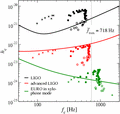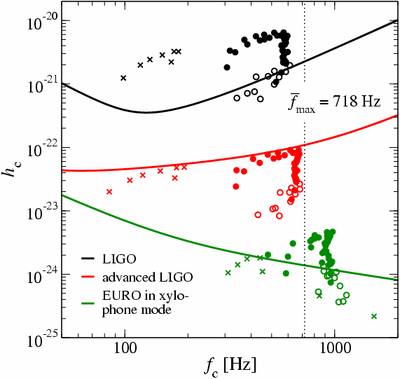| MPA-HOMEPAGE |
|
 |
Gravitational Radiation from General Relativistic Rotational Core Collapse with Microphysics | ||
|
|
 Go to:
|
H. Dimmelmeier ( C.D. Ott ( H.-T. Janka A. Marek Ian Hawke ( B. Zink ( E. Schnetter ( E. Müller Introduction: While light or sound waves propagate through space and time, gravitational waves are propagating ripples of space and time itself. Such distortions of spacetime are generated by catastrophic astrophysical phenomena involving extremely compact objects (like e.g. colliding and merging black holes or neutron stars, or the collapsing core of a star in a supernova event). Although gravitational waves were predicted by Einstein already at the beginning of the 20th century, only now we have the technology to venture the first successful detection. Currently, five kilometer-class Laser interferometer detectors are actively scanning the sky for incoming gravitational waves from both Galactic and extragalactic events. A successful direct detection will not only unequivocally prove Einstein's bold prediction, but even more interestingly, will open a completely new "window" onto the universe. One example of a promising source of gravitational waves is the gravitational collapse of the rotating core of a massive star to a neutron star and the subsequent explosion of the star in a spectacular supernova event. However, so far the search for gravitational waves from a supernova was impeded by the rather crude knowledge of the expected burst signal from the core bounce. Theoretical predictions of the gravitational wave signal produced this astrophysical scenario are complicated, as the emission mechanisms are very diverse. While the prospective gravitational wave burst signal from the core collapse, bounce, and early postbounce phase is present only when the pre-collapse core rotates, one expects signals with sizeable amplitudes also from convective motions at later post-bounce phases, anisotropic neutrino emission, excitation of various oscillations in the PNS, or nonaxisymmetric rotational instabilities.
As a first approach, in a Simulations: Greatly improving on these previous results, we have accomplished new multi-dimensional supercomputer simulations of many rotating stellar core collapse models [Ott, et al., 2006b, Dimmelmeier, et al., 2007]. In contrast to the old simpler computations, now much better initial models for the pre-collapse stellar cores were used, a more realistic microphysical description of matter was implemented, and the effects of neutrinos during the contraction phase were taken into account. As initial configuration we choose the presupernova stellar model s20 [Woosley, et al., 2002], on which we impose rotation [Komatsu, et al., 1989a, Komatsu, et al., 1989b] with different rates and profiles. During core collapse, we utilize a microphysical equation of state [Shen, et al., 1998] specifically designed for supernova core collapse. To approximate the effects of neutrinos in the infall phase, a very efficient parametric deleptonization scheme is used [Liebendörfer, 2005]. 
Most interestingly, with all these important improvements taken into account, the previously obtained diversity of the gravitational wave signals disappears, with only one signal type surviving [Dimmelmeier, et al., 2007]. This type is known as Type I and is characterized by a positive pre-bounce signal rise and a large negative spike during bounce, followed by a ring-down phase during which the signal slowly dies off. The finding that for the 54 improved models the gravitational wave templates become more generic has important implications for a possible detection of such an event. Obviously, with better knowledge of the expected signal and more robust predictions, fine-tuned data analysis methods can be applied to extract such signals from the data streams measured in the detectors. With such techniques and a combined effort of several detectors, the detection range can probably be extended far beyond our Galaxy in the near future. This greatly increases the prospects for a signal detection, as otherwise hopes would solely rest on the rather rare event of a supernova in our own Galaxy. In addition, we have followed the evolution of several models with more rapid rotation to longer times after core bounce. We find that these models exhibit the rapid growth of a nonaxisymmetric instability, which is also a strong emission mechanism for gravitational waves [Ott, et al., 2006a, Ott, et al., 2006b, Ott, et al., 2006c]. Here our simulations remove the limitations of previous studies and demonstrate that the development of nonaxisymmetric structures is neither limited to Newtonian gravity, simple matter models, equilibrium configurations, nor extremely strong rotation above the classical thresholds for the onset of nonaxisymmetric instabilities, but may rather be a phenomenon occurring generically in differentially rotating compact stars.
We provide a
|